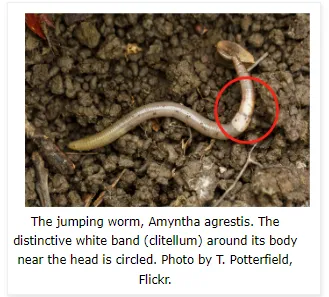Amynthas agrestis

The jumping worm, Amynthas agrestis, is an invasive earthworm that has been recently reported in a yard in Arcata. The local extent of this invasive organism is currently unknown. It is typically introduced and spread via potted plants, potting mixes, or mulch.
The California Department of Food and Agriculture (CDFA) has labeled the jumping worm as an A-rated pest, meaning it can cause economic or environmental harm if it becomes established in the state. The jumping worm can be distinguished from other earthworms by a milky-white band (the clitellum) wrapping all around and flush with its body near the head as well as its characteristic “jumping” when disturbed.
Have you seen it? Let us know
In nurseries, any jumping worms that are present are likely to be found underneath pots sitting on the ground or on landscape fabric. In forests and gardens they tend to be near the surface, just under accumulations of leaf litter or mulch. The Cornell Cooperative Extension has outlined some ways that individuals can help control their spread, including:
- Not using them intentionally for bait or gardening.
- Pouring a mixture containing a gallon of water and one-third cup of ground yellow mustard on to your soil, which will force worms to the surface for removal.
- Covering damp soil in the late spring or summer with transparent polyethylene for two to three weeks or until the soil temperature reaches 104 degrees Fahrenheit for a minimum of three days.
- Picking them out of the soil and putting them in a bag, then throwing the bag away or leaving the bag in the sun for at least 10 minutes and then tossing it.
Read more about identifying and controlling the jumping worm.
